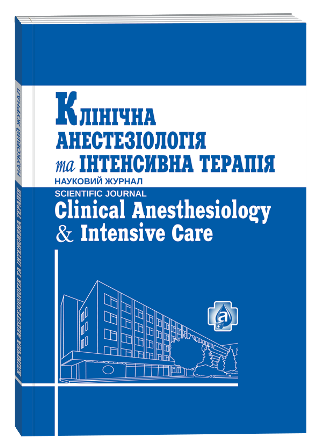ОСОБЛИВОСТІ ВІДНОВЛЕННЯ ПІСЛЯ АНЕСТЕЗІЇ У ПАЦІЄНТІВ ХІРУРГІЧНОГО ПРОФІЛЮ З ПЕРВИННИМИ ВЕНТРАЛЬНИМИ ГРИЖАМИ З НАДЛИШКОВОЮ МАСОЮ ТІЛА
DOI:
https://doi.org/10.31379/2411.2616.16.2.6Ключові слова:
избыточная масса тела, саркопеничне ожирение, дефицит витамина Д, ERAS-протоколАнотація
Статья посвящена вопросам возможности реализации ERAS-программы у пациентов с избыточной массой тела, у которых были определено саркопеническое ожирение с соответствующими изменениями в функциональном состоянии. Цель: повышение эффективности лечения больных хирургического профиля с избыточной массой тела путем разработки методов профилактики послеоперационных осложнений при проведении анестезии и интенсивной терапии в периоперационном периоде. Методы: назначение дополнительно к комплексу периоперационной интенсивной терапии веществ, недостаточность которых возникла за счет изменений в организме пациентов, вызванных наличием избыточной массы тела более 10 лет. Результаты. Важным в реализации ERAS-протокола у больных с избыточной массой тела с первичными вентральными грыжами является максимальное восстановление после операции таких показателей, как активность, сознание, дыхание, кровообращение, насыщение крови кислородом. Дефицит витамина Д у больных с избыточной массой тела свидетельствует о наличии ожирения, несмотря на ИМТ в пределах 25,0-29,9 и обусловлен его накоплением именно в жировой ткани. У таких больных накопления жира происходит вместе с саркопенией, и, как следствие, со снижением активности. Дополнительное введение колекальциферола и раствора D-фруктозо-1,6-дифосфат натриевой соли гидрата в протокол интенсивной терапии у пациентов с избыточной массой тела, которые нуждались в перативном вмешательстве по поводу первичной вентральной грыжи позволило у 100% из них реализовать ERAS- протокол.
Посилання
Визуализация тканей передней брюшной стенки при послеоперационных вентральных грыжах. / Толкачёв К.С. та ін. Сибирское медицинское обозрение. 2017. №3. С. 89-94.
Parshikov, V.V., Loginov, V.I. An abdominal wall components separation technique in treatment of patients with ventral and incisional hernias (review). Sovremennye tehnologii v medicine. 2016. Вип. 8(1). С.182–194,
Результаты хирургического лечения больных с большими и сложными послеоперационными грыжами передней брюшной стенки в условиях многопрофильного стационара. / Деговцов Е.Н. та ін. Бюллетень сибирской медицины. 2018. Вип. 17 (3). С. 35–44.
Имангазинов С.Б., Каирханов Е.К., Казангапов Р.С. Послеоперационные вентральные грыжи. Хирургическое лечение и профилактика раневых осложнений. Обзор литературы. Наука и Здравоохранение. 2019. Вип. 1 (Т.21). С. 29-4.
Umbilical Hernia Repair: Analysis After 934 Procedures. / Porrero, J.L. et al. Am Surg. 2015. Вип. 81(9). С. 899-903.
Затевахин И.И., Кириенко А.И., Кубышкин В.А. Абдоминальная хирургия: национальное руководство, краткое издание. ГЭОТАР-Медиа. Москва. 2016.
Horwood J., Ratnam S., Maw A. Decisions to operative: the ASA grade 5 dilemma. Ann. R. Coll. Surg. Engl. 2011. Вип. 93(5). С. 365-369.
Сарсенбаева Г.И., Турсынбекова А.Е. Современные подходы к оценке коморбидности у пациентов. CardioСоматика. 2019. Вип. 10 (1). С. 19–23.
Безденежных А.В., Сумин А.Н. Оценка риска сердечно-сосудистых осложнений при внесердечных оперативных вмешательствах: коморбидность и применение шкал клинической оценки. Сибирское медицинское обозрение. 2017. Вип. 5. С. 90-105.
Ежевская А.А., Прусакова Ж.Б., Загреков В.И. Тактика декураризации сугаммадексом для интра- и послеоперационного пробуждения пациентов с повторным введением рокурониума в спинальной хирургии. Анестезиология и реаниматология. 2017. Вип. 62(3). С. 194-198.
Cравнение эффектов ингаляционной и внутривенной анестезии при трансвагинальной пункции яичников. / Ушаков И.Л. та ін. Доктор.Ру. 2017. Вип. 6(135). С. 50–54.







